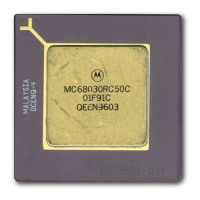Instruction Set Summary
3-12 MC68030 USER’S MANUAL MOTOROLA
3.2.9 System Control Instructions
Privileged instructions, trapping instructions, and instructions that use or modify the
condition code register (CCR) provide system control operations. Table 3–9 summarizes
these instructions. The TRAPcc instruction uses the same conditional tests as the
corresponding program control instructions. All of these instructions cause the processor to
flush the instruction pipe.
Table 3-9. System Control Operations
Instruction Operand Syntax Operand Size Operation
Privileged
ANDI #〈data〉,SR 16 immediate data Λ SR → SR
EORI #〈data〉,SR 16 immediate data x SR → SR
MOVE 〈ea〉,SR
SR,〈ea〉
16
16
source → SR
SR → destination
MOVE USP,An
An,USP
32
32
USP → An
An → USP
MOVEC Rc,Rn
Rn,Rc
32
32
Rc → Rn
Rn → Rc
MOVES Rn, 〈ea〉
〈ea〉,Rn
8, 16, 32 Rn → destination using DFC
source using SFC → Rn
ORI #〈data〉,SR 16 immediate data V SR → SR
RESET none none assert RESET
line
RTE none none (SP) → SR; SP + 2 → SP; (SP) → PC; SP + 4 → SP;
Restore stack according to format
STOP #〈data〉 16 immediate data → SR; STOP
Trap Generating
BKPT #〈data〉 none run breakpoint cycle, then trap as illegal instruction
CHK 〈ea〉,Dn 16, 32 if Dn < 0 or Dn > (ea), then CHK exception
CHK2 〈ea〉,Rn 8, 16, 32 if Rn < -lower bound or Rn > -upper bound, then CHK
exception
ILLEGAL none none SSP — 2 → SSP; Vector Offset→ (SSP);
SSP — 4 → SSP; PC→ (SSP);
SSP — 2 → SSP; SR→ (SSP);
Illegal Instruction Vector Address → PC
TRAP #〈data〉 none SSP — 2 → SSP; Format and Vector Offset→(SSP)
SSP — 4 → SSP; PC→(SSP); SSP — 2 → SSP;
SR→(SSP); Vector Address → PC
TRAPcc none
#〈data〉
none
16, 32
if cc true, then TRAP exception
TRAPV none none if V, then take overflow TRAP exception
Condition Code Register
ANDI #〈data〉,CCR 8 immediate data Λ CCR → CCR
EORI #〈data〉,CCR 8 immediate data ⊕ CCR → CCR
MOVE 〈ea〉,CCR
CCR,〈ea〉
16
16
source → CCR
CCR → destination
ORI #〈data〉,CCR 8 immediate data V CCR → CCR

